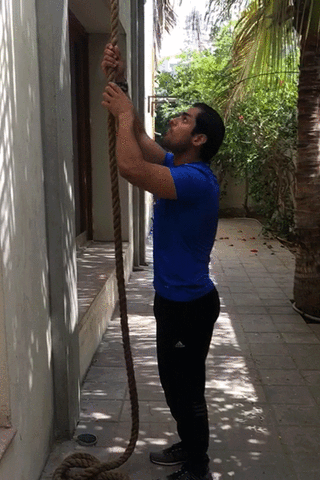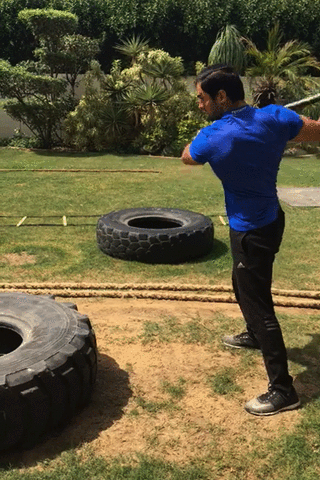Karachi's latest fitness trend looks hardcore, but does it work? We ask an expert
Forget treadmills, forget ellipticals, forget the regular gym equipment you spend hours sweating on — fitness trends have changed.
Enter battle ropes, peg boards, weighted sleds, tyres, sledgehammers.
Celebrities ranging from Victoria's Secret Angels, who look like they were born to use battle ropes, to Keira Knightley, who has a knack for indoor rock climbing, to fitness expert Jillian Michaels, who sheds pounds while letting off steam during sledgehammer workouts are all proof that these exercises are super trendy right now.
Even gyms and fitness programs in Pakistan have caught on now.
They look cool, but do these trendy workouts... work?
We wanted to get the scoop so we got in touch with personal trainer Usman Samir, an alumni of the Combined Cadet Force (CCF) in England, who found his passion for fitness and went on to study the art of movement, biomechanics and basics of anatomy.
A fitness trainer for three years; a year of running his own boot camp called Fitness 360 and then leaving it to become a personal trainer, Samir explains why he specifically employs the use of this equipment for his exclusive roster of clients.

"Exercises should mimic movement in real life, they should be movement-based," he says, illustrating that the purpose of the equipment is not only for physical strength and benefits thereafter, but also to aid individuals during daily activities.
The trainer stresses on the need for exercises to have functionality in real life. Squats, for instance, imitate the motion of sitting on a chair, while farmer's walk emulates the action of carrying grocery bags, and deadlifts the movement of picking something up from the ground.
"Our ancestors climbed trees (peg boards), they lifted heavy boulders (tyre flips), they didn't do jumping jacks," says Samir taking a jibe at the fast-growing boot camp trend in Pakistan.
He adds, "I have a very niche clientele, I only work through referrals and it's important for me as a trainer, and my clients — many of whom I cannot name due to security reasons — that I train them keeping many factors in mind, like movement and form."
The key to working out, Samir points out is that "each movement should become stronger. The aim is to perform each exercise with perfect form."
To better explain the use of equipment he swears by, he takes us around his training space in his garden and backyard and shows us how to perform these functional training exercises.
Weighted sled, pull-push

Targets: Legs, arms and core; glutes, calves, core, hamstrings, quads.
How to: Sit/ stand a fair distance from the sled. (You can perform this exercising while sitting on the ground or standing, sitting works your abdominals to a greater degree). Start by pulling the sled towards you with the rope. Once you've pulled the sled all the way towards you, stand up and push the sled all the way back as fast as possible. Repeat.
This is a great functional pulling exercise which further works your grip strength, forearms, biceps and lats (largest back muscle) unilaterally. It helps build strength and aids in rope climbing.
Bonus: The weighted sled allows you to work with weights. Load up if you're feeling adventurous and see how far you can push yourself.
Battle ropes (double arm wave)

Targets: Arms, shoulders, core and hips; quadriceps, forearms, biceps, back.
How to: Grab a hold of the ropes at arm's length and squat low. Pull taut your core and move both arms up to shoulder height and down to hip level. Make waves as fast as possible and try to make sure they reach the anchor. Repeat. You can change it up by alternating your arms and also doing alternate lunges.
Battle ropes are perfect for those looking to ditch treadmill cardio sessions. They help torch fat and work cardio levels to the max.
Bonus: Various positions work the body harder. For example, kneeling on your knees focuses more on upper body strength and makes it harder to get waves till the very end.
Farmer's Walk

Targets: Full body; forearms, shoulders, upper back, core and legs.
How to: Grab a pair of dumbbells (try to go for weights around 50% of your body weight per hand). Look straight, core contracted, hips facing forward and chest high. Walk towards a marked distance. No wobbling or penguin walks. Once you complete the distance. Let drop the dumbbells. Turn around to face the starting point. Lift the dumbbells again and complete the first rep. Repeat.
This functional exercises helps in improving grip strength and core stability.
Bonus: Keep increasing the weight and distance to challenge yourself.
Tyre flips

Targets: Full body; arms, back, core and legs.
How to: Warm up the muscles by doing a few weight lifting exercises. Then squat low, close to the tyre, keeping your feet gripped firmly to the ground and make sure your back is not rounded. Keep your arms shoulder-width apart, wider than your legs and grab the underside of the tyre. Lean in and keep your weight on the balls of your feet. Keeping your core, back and arms engaged, heave the tyre up with full force, like an explosion. Once it's above your waist, lift one knee and plant that leg ahead to assist the push. Repeat.
If the tyre starts falling backwards, move away immediately so it does not fall on you or your feet.
Tyre flips are essentially a functional/ strength exercise which helps build power.
Warning: Albeit effective, tyre flips are dangerous and should be performed with utmost caution.
Rope climbing

Targets: Upper body; arms, shoulders and core (lower body, if legs are engaged).
How to: Grab a hold of the rope, one arm above the other, keeping the rope between the legs. Bend the elbows, contract the core, and pull yourself up from the arm holding the rope above, while simultaneously moving the lower arm to reach above the other arm. Repeat.
Bonus: To challenge your upper body strength, put on ankle weights and perform this exercise. To make it easier, wrap your legs around the rope and use your arms and legs to pull yourself up.
Ring dips

Targets: Upper body; triceps, chest, shoulders and core.
How to: Clutch the rings, wrapping your hand firmly around them and keeping the ring snug between the curve of your palm. Start by bending your elbows and legs slightly, keep your shoulders close to your sides. Push up with your legs, keeping your back straight, at the same time propel yourself up with your arms, cross your legs at the ankle once up, if need be. Bend at the elbows and lower your body, but don't touch the ground. Repeat.
Dips also work core stability while primarily focusing on arms and shoulders.
Bonus: Strap on a weighted vest to add more weight.
Warning: Do not perform this exercise if you have any serious shoulder, wrist or elbow injuries.
Peg board

Targets: Upper body; arms, shoulders, forearms and core.
How to: Grab the pegs and place them in the lowest holes. Lift yourself up in a regular pull up position, till your chin/ chest reach the same level as the pegs. No swinging, or arcs, keep your body straight and elbows close to your sides. Pull one peg out -- keep the other one stable and firm -- and place it in the next hole at arm's length above and pull up. Alternate between the two till you reach as high as you can go and then come down following the same steps in reverse order. Repeat.
This pulling exercise helps build unilateral strength in your pulling mechanics and core stability.
Warning: Do not perform this exercise if you have any serious shoulder, wrist or elbow injuries.
Sledgehammer

Targets: Upper body; arms, shoulders and core.
How to: Grab a sledgehammer, be mindful of the weight. Stand a few feet away from the tyre. Grip the sledgehammer with your left hand clutching the bottom of the handle and the right hand wrapped nearer to the head (switch if you're left-handed). Take the sledgehammer back and up moving it in a rotational movement, your right hand should move towards the head. As you swing it to the front with full force and bring the sledgehammer down, your right hand should slide to meet your left. Alternate both sides. Repeat.
Note: Always consult your doctor before engaging in any resistance exercises. Make sure to seek expert advice and guidance from a qualified and experienced trainer before lifting weights. Form is key to proper function. It is imperative to first study and understand each movement before engaging in the above mentioned exercises. Train smarter, not harder, guys.
You can follow Usman Samir on Instagram.





Comments